【留学人才网】投行面试经典答案集
- 格式:docx
- 大小:38.98 KB
- 文档页数:3
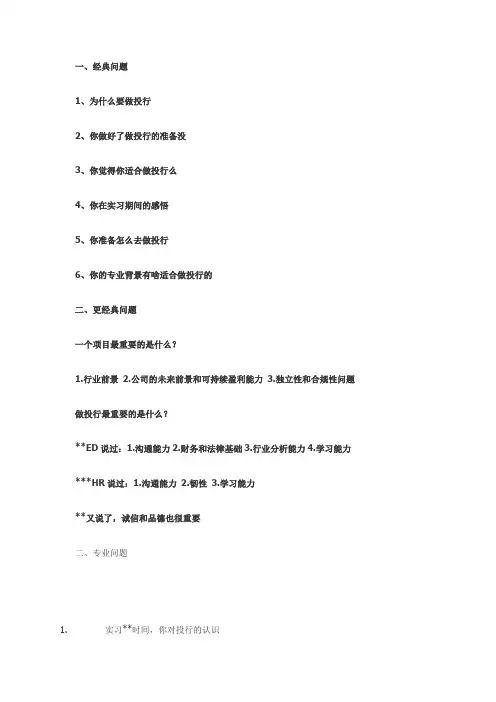
一、经典问题1、为什么要做投行2、你做好了做投行的准备没3、你觉得你适合做投行么4、你在实习期间的感悟5、你准备怎么去做投行6、你的专业背景有啥适合做投行的二、更经典问题一个项目最重要的是什么?1.行业前景2.公司的未来前景和可持续盈利能力3.独立性和合规性问题做投行最重要的是什么?**ED说过:1.沟通能力2.财务和法律基础3.行业分析能力4.学习能力***HR说过:1.沟通能力2.韧性3.学习能力**又说了,诚信和品德也很重要二、专业问题1.实习**时间,你对投行的认识投行的作用:在于综合协调其他中介机构的意见,根据自己的尽职调查结果,为公司上市制定合理的改制方案和上市方案,为推动企业执行;讲个好故事,将拟上市公司从丑小鸭变成美丽的天鹅,卖个好价钱1.投行与pe的区别Pe作为投资者,投行仅是中介机构,确切的讲,投行是为pe等投资者服务的。
具体区别:投资阶段更靠前,投资行业范围更广泛,投资时间更长线,对企业提供的增值服务更贴切,这是PE的价值所在。
2. BS,IS和CFS三个表哪个最重要1.资产负债表:反映企业在某一特定日期财务状况的(静态)会计报表,通过该表了解企业资产(负责)总量及结构、投资者(老板)所拥有的权益。
2.利润表:反映企业在一定会计期间的经营成果的(动态)会计报表,可以一目了然从表中看到经营业绩形成过程,收入来源、成本费用消耗、净利润等。
3.现金流量表:反映企业在一定会计期间现金和现金等价物流入和流出的会计报表。
表中项目从不同角度反映企业业务活动的现金流入与流出,弥补了资产负债表和利润表提供信息的不足(了解净利润的质量)。
以上“三表”既有侧重又相互补充,真正要说出那张表最重要,一定没有唯一的答案,一定是因(使用者立场)人而异。
1.如何从报表看公司财务是否舞弊(报表看公司财务的问题)1.与同类公司或与公司历史比较,毛利率明显异常;2.货币资金和银行贷款同时高企;3.应收账款、存货异常增加;4.估算的应交所得税余额与实际余额相比相差甚远;5.现金净流量长期低于净利润。
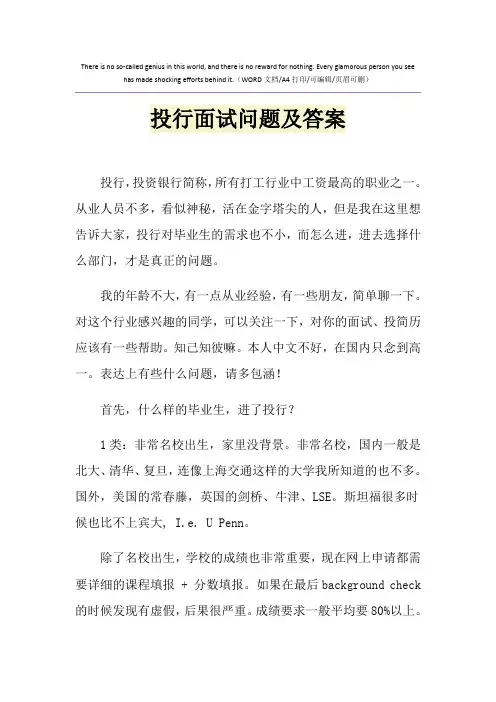
There is no so-called genius in this world, and there is no reward for nothing. Every glamorous person you see has made shocking efforts behind it.(WORD文档/A4打印/可编辑/页眉可删)投行面试问题及答案投行,投资银行简称,所有打工行业中工资最高的职业之一。
从业人员不多,看似神秘,活在金字塔尖的人,但是我在这里想告诉大家,投行对毕业生的需求也不小,而怎么进,进去选择什么部门,才是真正的问题。
我的年龄不大,有一点从业经验,有一些朋友,简单聊一下。
对这个行业感兴趣的同学,可以关注一下,对你的面试、投简历应该有一些帮助。
知己知彼嘛。
本人中文不好,在国内只念到高一。
表达上有些什么问题,请多包涵!首先,什么样的毕业生,进了投行?1类:非常名校出生,家里没背景。
非常名校,国内一般是北大、清华、复旦,连像上海交通这样的大学我所知道的也不多。
国外,美国的常春藤,英国的剑桥、牛津、LSE。
斯坦福很多时候也比不上宾大, I.e. U Penn。
除了名校出生,学校的成绩也非常重要,现在网上申请都需要详细的课程填报 + 分数填报。
如果在最后background check 的时候发现有虚假,后果很严重。
成绩要求一般平均要80%以上。
(这里澄清一下,投行也有很多国家的,例如DB德银,BNP法巴,Normura日本野村,Macquarie澳洲麦格利,这些投行也承认本国家的顶尖大学,如东大,海德堡等。
)2类:背景非常强,学校也不一般。
这类人,背景深到可以是某上市公司高管的亲属,或者国家某部高层的亲属。
大学也基本是名校,在校成绩不能太差,国内交通大学、人民大学等在范畴之内,国外的帝国理工、南加州大学等也是。
其实,超级名校的要求也不是很绝对。
非常出色的人,来自帝国理工、南加州,不靠关系进投行的也有,但是还是少数。
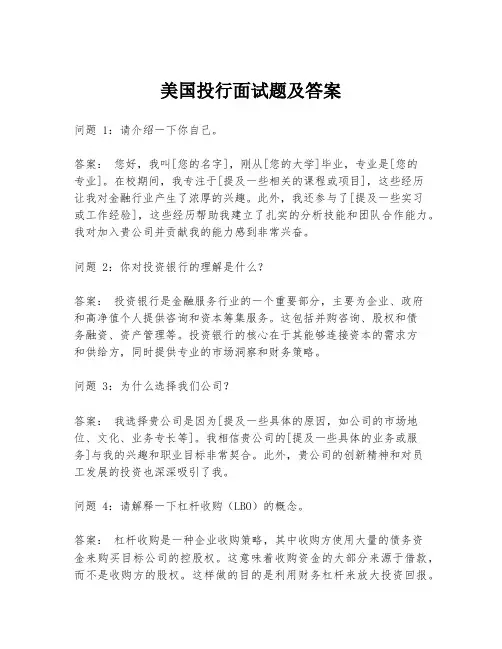
美国投行面试题及答案问题 1:请介绍一下你自己。
答案:您好,我叫[您的名字],刚从[您的大学]毕业,专业是[您的专业]。
在校期间,我专注于[提及一些相关的课程或项目],这些经历让我对金融行业产生了浓厚的兴趣。
此外,我还参与了[提及一些实习或工作经验],这些经历帮助我建立了扎实的分析技能和团队合作能力。
我对加入贵公司并贡献我的能力感到非常兴奋。
问题 2:你对投资银行的理解是什么?答案:投资银行是金融服务行业的一个重要部分,主要为企业、政府和高净值个人提供咨询和资本筹集服务。
这包括并购咨询、股权和债务融资、资产管理等。
投资银行的核心在于其能够连接资本的需求方和供给方,同时提供专业的市场洞察和财务策略。
问题 3:为什么选择我们公司?答案:我选择贵公司是因为[提及一些具体的原因,如公司的市场地位、文化、业务专长等]。
我相信贵公司的[提及一些具体的业务或服务]与我的兴趣和职业目标非常契合。
此外,贵公司的创新精神和对员工发展的投资也深深吸引了我。
问题 4:请解释一下杠杆收购(LBO)的概念。
答案:杠杆收购是一种企业收购策略,其中收购方使用大量的债务资金来购买目标公司的控股权。
这意味着收购资金的大部分来源于借款,而不是收购方的股权。
这样做的目的是利用财务杠杆来放大投资回报。
当然,这也带来了更高的风险,因为债务服务成本必须通过收购后的公司现金流来支付。
问题 5:如果让你评估一家公司的潜在投资价值,你会考虑哪些因素?答案:评估一家公司的潜在投资价值时,我会考虑以下几个关键因素:公司的财务状况,包括收入、利润和现金流;公司的市场地位和竞争优势;管理团队的能力和经验;行业趋势和宏观经济因素;以及公司的增长潜力和未来的盈利能力。
问题 6:你如何处理工作中的压力?答案:面对工作压力,我首先确保我有清晰的优先级和时间管理策略。
我会将大任务分解为小步骤,并专注于一步一步地完成。
此外,我也经常与同事沟通,寻求他们的意见和帮助。
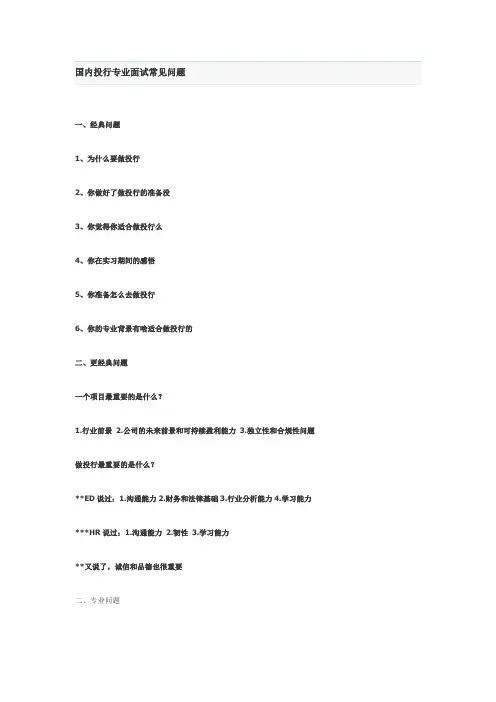
一、经典问题1、为什么要做投行2、你做好了做投行的准备没3、你觉得你适合做投行么4、你在实习期间的感悟5、你准备怎么去做投行6、你的专业背景有啥适合做投行的二、更经典问题一个项目最重要的是什么?1.行业前景2.公司的未来前景和可持续盈利能力3.独立性和合规性问题做投行最重要的是什么?**ED说过:1.沟通能力2.财务和法律基础3.行业分析能力4.学习能力***HR说过:1.沟通能力2.韧性3.学习能力**又说了,诚信和品德也很重要二、专业问题1.实习**时间,你对投行的认识投行的作用:在于综合协调其他中介机构的意见,根据自己的尽职调查结果,为公司上市制定合理的改制方案和上市方案,为推动企业执行;讲个好故事,将拟上市公司从丑小鸭变成美丽的天鹅,卖个好价钱1.投行与pe的区别Pe作为投资者,投行仅是中介机构,确切的讲,投行是为pe等投资者服务的。
具体区别:投资阶段更靠前,投资行业范围更广泛,投资时间更长线,对企业提供的增值服务更贴切,这是PE的价值所在。
2. BS,IS和CFS三个表哪个最重要1.资产负债表:反映企业在某一特定日期财务状况的(静态)会计报表,通过该表了解企业资产(负责)总量及结构、投资者(老板)所拥有的权益。
2.利润表:反映企业在一定会计期间的经营成果的(动态)会计报表,可以一目了然从表中看到经营业绩形成过程,收入来源、成本费用消耗、净利润等。
3.现金流量表:反映企业在一定会计期间现金和现金等价物流入和流出的会计报表。
表中项目从不同角度反映企业业务活动的现金流入与流出,弥补了资产负债表和利润表提供信息的不足(了解净利润的质量)。
以上“三表”既有侧重又相互补充,真正要说出那张表最重要,一定没有唯一的答案,一定是因(使用者立场)人而异。
1.如何从报表看公司财务是否舞弊(报表看公司财务的问题)1.与同类公司或与公司历史比较,毛利率明显异常;2.货币资金和银行贷款同时高企;3.应收账款、存货异常增加;4.估算的应交所得税余额与实际余额相比相差甚远;5.现金净流量长期低于净利润。
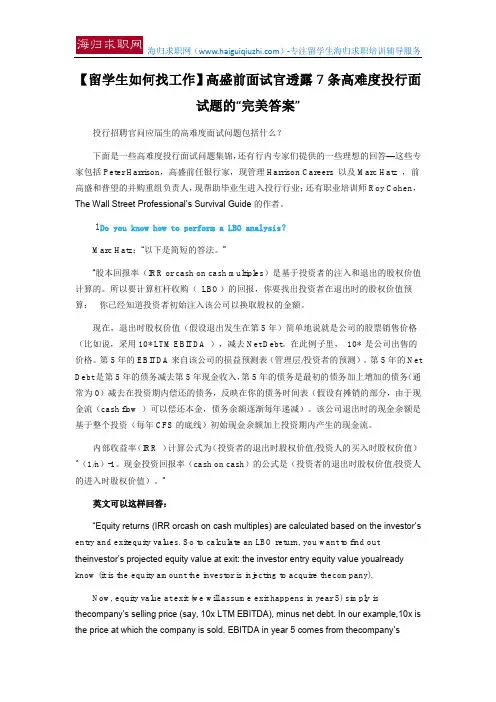
【留学生如何找工作】高盛前面试官透露7条高难度投行面试题的“完美答案”投行招聘官问应届生的高难度面试问题包括什么?下面是一些高难度投行面试问题集锦,还有行内专家们提供的一些理想的回答—这些专家包括Peter Harrison,高盛前任银行家,现管理Harrison Careers 以及Marc Hatz ,前高盛和普望的并购重组负责人,现帮助毕业生进入投行行业;还有职业培训师Roy Cohen,The Wall Street Professional‘s Survival Guide的作者。
1Do you know how to perform a LBO analysis?Marc Hatz:―以下是简短的答法。
‖―股本回报率(IRR or cash on cash multiples)是基于投资者的注入和退出的股权价值计算的。
所以要计算杠杆收购(LBO)的回报,你要找出投资者在退出时的股权价值预算:你已经知道投资者初始注入该公司以换取股权的金额。
现在,退出时股权价值(假设退出发生在第5年)简单地说就是公司的股票销售价格(比如说,采用10* LTM EBITDA ),减去Net Debt。
在此例子里,10* 是公司出售的价格。
第5年的EBITDA来自该公司的损益预测表(管理层/投资者的预测)。
第5年的Net Debt是第5年的债务减去第5年现金收入,第5年的债务是最初的债务加上增加的债务(通常为0)减去在投资期内偿还的债务,反映在你的债务时间表(假设有摊销的部分,由于现金流(cash flow )可以偿还本金,债务余额逐渐每年递减)。
该公司退出时的现金余额是基于整个投资(每年CFS的底线)初始现金余额加上投资期内产生的现金流。
内部收益率(IRR )计算公式为(投资者的退出时股权价值/投资人的买入时股权价值)^(1/n)-1。
现金投资回报率(cash on cash)的公式是(投资者的退出时股权价值/投资人的进入时股权价值)。
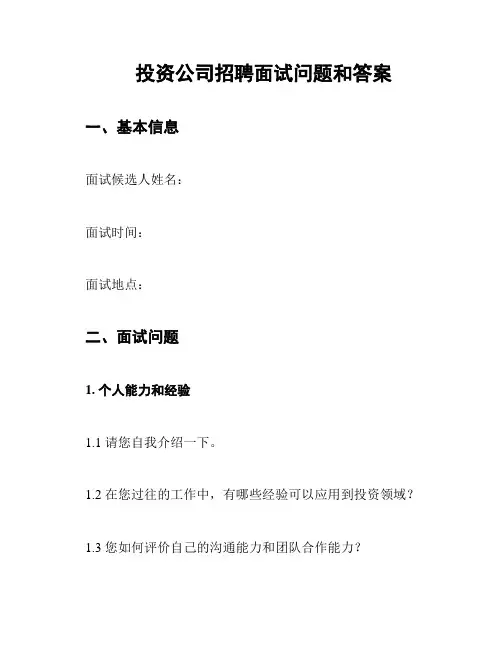
投资公司招聘面试问题和答案一、基本信息面试候选人姓名:面试时间:面试地点:二、面试问题1. 个人能力和经验1.1 请您自我介绍一下。
1.2 在您过往的工作中,有哪些经验可以应用到投资领域?1.3 您如何评价自己的沟通能力和团队合作能力?2. 投资知识2.1 请简述一下您对投资的理解。
2.2 您如何看待当前的投资市场环境?2.3 请举例说明您在过往的投资过程中,是如何进行风险管理和控制的?2.4 在面对不同的投资项目和标的时,您是如何进行选择的?3. 业务理解3.1 请您谈谈对我们公司的了解,以及您认为公司的发展前景如何?3.2 您如何看待投资公司的业务战略和发展方向?3.3 请谈谈您对我们公司投资理念的理解。
4. 问题解决能力4.1 如果在投资过程中出现了未预见的风险,您会如何处理?4.2 请您描述一次在过往工作中遇到的问题,并说明您是如何解决的。
4.3 面对市场变化,您会如何调整投资策略?5. 团队合作与领导力5.1 请谈谈您在团队合作中扮演的角色和贡献。
5.2 如果您在团队中发现了问题,您会如何处理?5.3 请举例说明您在过往的工作经历中,如何带领团队达成目标。
6. 自我提升6.1 您是如何保持自己在投资领域的专业知识和技能的?6.2 您在业余时间喜欢做什么?这些爱好如何帮助您提升自己?6.3 您在未来三年的职业规划是什么?三、面试答案1. 个人能力和经验1.1 作为一名拥有丰富投资经验的候选人,我在过去的工作中负责过多个投资项目,涉及领域包括股票、债券、基金等。
我具备扎实的分析能力和敏锐的市场洞察力,能够准确判断投资机会。
1.2 在我的过往工作中,我积极地与团队成员沟通协作,共同完成投资项目。
我具备较强的团队合作能力,能够与不同背景的人有效沟通,共同推进项目进展。
2. 投资知识2.1 在我看来,投资是一种通过分析市场和标的,以期获得长期稳定回报的行为。
投资需要深入研究市场、公司和行业,同时关注宏观经济和政策环境。
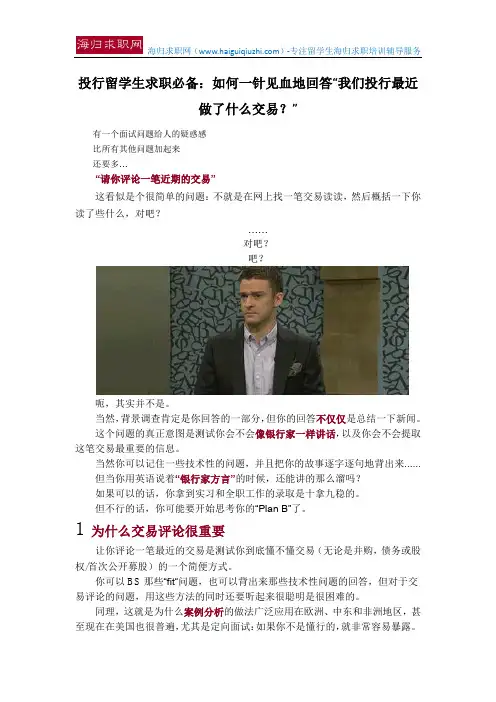
投行留学生求职必备:如何一针见血地回答“我们投行最近做了什么交易?”有一个面试问题给人的疑惑感比所有其他问题加起来还要多…“请你评论一笔近期的交易”这看似是个很简单的问题:不就是在网上找一笔交易读读,然后概括一下你读了些什么,对吧?……对吧?吧?呃,其实并不是。
当然,背景调查肯定是你回答的一部分,但你的回答不仅仅是总结一下新闻。
这个问题的真正意图是测试你会不会像银行家一样讲话,以及你会不会提取这笔交易最重要的信息。
当然你可以记住一些技术性的问题,并且把你的故事逐字逐句地背出来......但当你用英语说着“银行家方言”的时候,还能讲的那么溜吗?如果可以的话,你拿到实习和全职工作的录取是十拿九稳的。
但不行的话,你可能要开始思考你的“Plan B”了。
1为什么交易评论很重要让你评论一笔最近的交易是测试你到底懂不懂交易(无论是并购,债务或股权/首次公开募股)的一个简便方式。
你可以BS那些“fit“问题,也可以背出来那些技术性问题的回答,但对于交易评论的问题,用这些方法的同时还要听起来很聪明是很困难的。
同理,这就是为什么案例分析的做法广泛应用在欧洲、中东和非洲地区,甚至现在在美国也很普遍,尤其是定向面试:如果你不是懂行的,就非常容易暴露。
在有评估中心和考察能力的相关问题地区,比如欧洲、中东和非洲以及部分亚太地区,交易陈述可能会以笔头考察的形式出现,或者以评估中心给出的案例分析的形式。
2你应该做哪些准备?选择一笔交易去做研究其实并不是个特别复杂的事:关注一些比较大的,在主流媒体上都有报道的交易,并且就在你感兴趣的领域找一些近期的交易。
你也可以用Dealogic所提供的服务来订阅消息提醒,它们能在第一时间告诉你你感兴趣的领域所产生的新交易;你甚至可以从一些特定的银行得到债务/股权融资交易信息,比如:∙高盛∙摩根斯坦利∙摩根大通∙德意志银行∙花旗银行在很久很久以前,得到交易信息是更容易的,因为华尔街日报以前在它的“Money Beat”博客里发表“交易档案”。
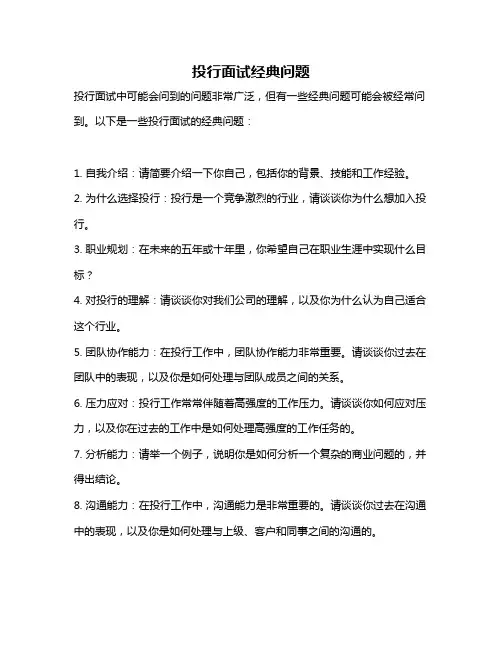
投行面试经典问题
投行面试中可能会问到的问题非常广泛,但有一些经典问题可能会被经常问到。
以下是一些投行面试的经典问题:
1. 自我介绍:请简要介绍一下你自己,包括你的背景、技能和工作经验。
2. 为什么选择投行:投行是一个竞争激烈的行业,请谈谈你为什么想加入投行。
3. 职业规划:在未来的五年或十年里,你希望自己在职业生涯中实现什么目标?
4. 对投行的理解:请谈谈你对我们公司的理解,以及你为什么认为自己适合这个行业。
5. 团队协作能力:在投行工作中,团队协作能力非常重要。
请谈谈你过去在团队中的表现,以及你是如何处理与团队成员之间的关系。
6. 压力应对:投行工作常常伴随着高强度的工作压力。
请谈谈你如何应对压力,以及你在过去的工作中是如何处理高强度的工作任务的。
7. 分析能力:请举一个例子,说明你是如何分析一个复杂的商业问题的,并得出结论。
8. 沟通能力:在投行工作中,沟通能力是非常重要的。
请谈谈你过去在沟通中的表现,以及你是如何处理与上级、客户和同事之间的沟通的。
9. 项目执行:请举一个例子,说明你是如何在项目中起到关键作用的,并帮助项目取得成功。
10. 问题解决能力:请举一个例子,说明你是如何解决一个复杂的商业问题的,并给出解决方案。
这些问题只是一些经典问题,实际上在投行面试中可能会问到更广泛的问题。
在准备面试时,建议做好充分的准备,了解公司的文化、业务和行业,以便更好地回答面试官的问题。
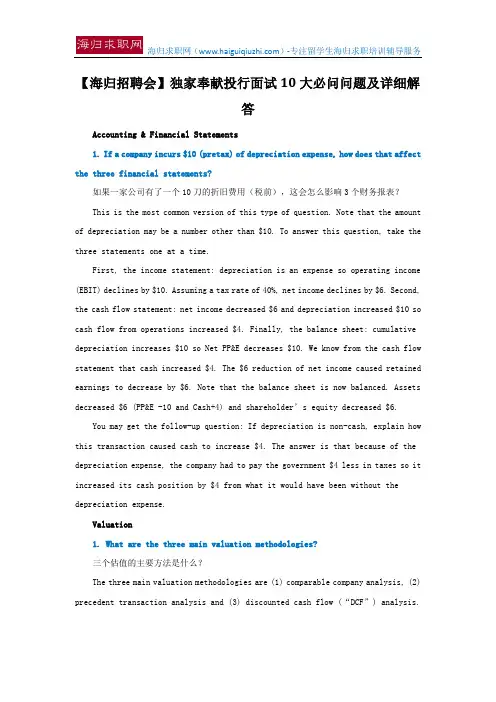
【海归招聘会】独家奉献投行面试10大必问问题及详细解答Accounting & Financial Statements1. If a company incurs $10 (pretax) of depreciation expense, how does that affect the three financial statements?如果一家公司有了一个10刀的折旧费用(税前),这会怎么影响3个财务报表?This is the most common version of this type of question. Note that the amount of depreciation may be a number other than $10. To answer this question, take the three statements one at a time.First, the income statement: depreciation is an expense so operating income (EBIT) declines by $10. Assuming a tax rate of 40%, net income declines by $6. Second, the cash flow statement: net income decreased $6 and depreciation increased $10 so cash flow from operations increased $4. Finally, the balance sheet: cumulative depreciation increases $10 so Net PP&E decreases $10. We know from the cash flow statement that cash increased $4. The $6 reduction of net income caused retained earnings to decrease by $6. Note that the balance sheet is now balanced. Assets decreased $6 (PP&E -10 and Cash+4) and shareholder’s equity decreased $6.You may get the follow-up question: If depreciation is non-cash, explain how this transaction caused cash to increase $4. The answer is that because of the depreciation expense, the company had to pay the government $4 less in taxes so it increased its cash position by $4 from what it would have been without the depreciation expense.Valuation1. What are the three main valuation methodologies?三个估值的主要方法是什么?The three main valuation methodologies are (1) comparable company analysis, (2) precedent transaction analysis and (3) discounted cash flow (“DCF”) analysis.2. Of the three main valuation methodologies, which ones are likely to result in higher/lower value?三个估值的主要方法中,哪一个会产生最高/低的值?Firstly, the Precedent Transactions methodology is likely to give a higher valuation than the Comparable Company methodology. This is because when companies are purchased, the target’s shareholders are typically paid a price that is higher than the target’s current stock price. Technically speaking, the purchase price includes a “control premium.” Valuing companies based on M&A transactions (a control based valuation methodology) will include this control premium and therefore likely result in a higher valuation than a public market valuation (minority interest based valuation methodology).The Discounted Cash Flow (DCF) analysis will also likely result in a higher valuation than the Comparable Company analysis because DCF is also a control based methodology and because most projections tend to be pretty optimistic. Whether DCF will be higher than Precedent Transactions is debatable but is fair to say that DCF valuations tend to be more variable because the DCF is so sensitive to a multitude of inputs or assumptions.3. How do you use the three main valuation methodologies to conclude value?你怎么运用三个主要的估值方法来计算公司估值?The best way to answer this question is to say that you calculate a valuation range for each of the three methodolog ies and then “triangulate” the three ranges to conclude a valuation range for the company or asset being valued. You may also put more weight on one or two of the methodologies if you think that they give you a more accurate valuation. For example, if you have good comps and good precedent transactions but have little faith in your projections, then you will likely rely more on the Comparable Company and Precedent Transaction analyses than on your DCF.Discounted Cash Flow1. Walk me through a Discounted Ca sh Flow (“DCF”) analysis.请叙述一下贴现现金流分析。
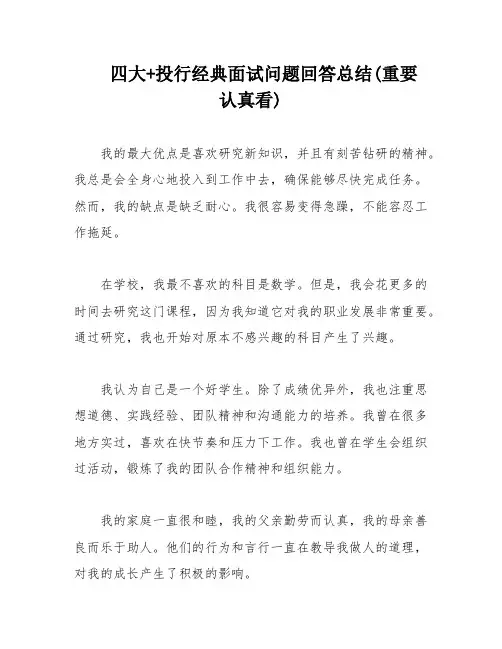
四大+投行经典面试问题回答总结(重要认真看)我的最大优点是喜欢研究新知识,并且有刻苦钻研的精神。
我总是会全身心地投入到工作中去,确保能够尽快完成任务。
然而,我的缺点是缺乏耐心。
我很容易变得急躁,不能容忍工作拖延。
在学校,我最不喜欢的科目是数学。
但是,我会花更多的时间去研究这门课程,因为我知道它对我的职业发展非常重要。
通过研究,我也开始对原本不感兴趣的科目产生了兴趣。
我认为自己是一个好学生。
除了成绩优异外,我也注重思想道德、实践经验、团队精神和沟通能力的培养。
我曾在很多地方实过,喜欢在快节奏和压力下工作。
我也曾在学生会组织过活动,锻炼了我的团队合作精神和组织能力。
我的家庭一直很和睦,我的父亲勤劳而认真,我的母亲善良而乐于助人。
他们的行为和言行一直在教导我做人的道理,对我的成长产生了积极的影响。
就我申请的这个职位而言,我认为我需要更多的实践经验和项目管理能力。
我会积极研究和提升自己,以更好地胜任这个职位。
回答提示:这个问题很棘手,但求职者不要直接说自己的缺点,而是说自己在某些方面还有提升的空间,然后提出自己正在积极努力改进的例子。
例如:“我发现自己在时间管理方面还有些欠缺,但我正在通过研究时间管理的技巧和规划来提高自己的效率。
”这样的回答既表现了求职者的诚实和自省,又展示了自己的积极进取精神。
4、你为什么离开上一家公司?回答提示:求职者不要在面试中抱怨或批评上一家公司或老板,这样会给面试官留下不好的印象。
可以说自己在上一家公司得到了宝贵的经验和机会,但现在想要挑战更高的职业发展,寻找更适合自己的机会。
如果是因为公司裁员或经济原因离开的,可以简单说明,但不要过多强调。
5、你对我们公司了解多少?回答提示:求职者在面试前应该对公司进行充分的了解,包括公司的发展历程、主营业务、市场竞争情况等。
在面试时可以简单介绍自己对公司的了解,并表达对公司的认同和兴趣。
例如:“我了解到贵公司在行业内拥有很高的知名度和市场地位,我对贵公司的业务和发展前景非常感兴趣,希望能够为贵公司做出贡献。
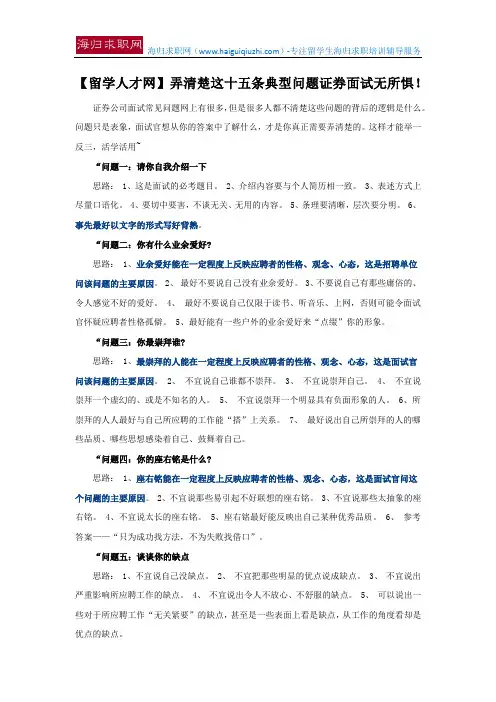
【留学人才网】弄清楚这十五条典型问题证券面试无所惧!证券公司面试常见问题网上有很多,但是很多人都不清楚这些问题的背后的逻辑是什么。
问题只是表象,面试官想从你的答案中了解什么,才是你真正需要弄清楚的。
这样才能举一反三,活学活用~“问题一:请你自我介绍一下思路: 1、这是面试的必考题目。
2、介绍内容要与个人简历相一致。
3、表述方式上尽量口语化。
4、要切中要害,不谈无关、无用的内容。
5、条理要清晰,层次要分明。
6、事先最好以文字的形式写好背熟。
“问题二:你有什么业余爱好?思路: 1、业余爱好能在一定程度上反映应聘者的性格、观念、心态,这是招聘单位问该问题的主要原因。
2、最好不要说自己没有业余爱好。
3、不要说自己有那些庸俗的、令人感觉不好的爱好。
4、最好不要说自己仅限于读书、听音乐、上网,否则可能令面试官怀疑应聘者性格孤僻。
5、最好能有一些户外的业余爱好来“点缀”你的形象。
“问题三:你最崇拜谁?思路: 1、最崇拜的人能在一定程度上反映应聘者的性格、观念、心态,这是面试官问该问题的主要原因。
2、不宜说自己谁都不崇拜。
3、不宜说崇拜自己。
4、不宜说崇拜一个虚幻的、或是不知名的人。
5、不宜说崇拜一个明显具有负面形象的人。
6、所崇拜的人人最好与自己所应聘的工作能“搭”上关系。
7、最好说出自己所崇拜的人的哪些品质、哪些思想感染着自己、鼓舞着自己。
“问题四:你的座右铭是什么?思路: 1、座右铭能在一定程度上反映应聘者的性格、观念、心态,这是面试官问这个问题的主要原因。
2、不宜说那些易引起不好联想的座右铭。
3、不宜说那些太抽象的座右铭。
4、不宜说太长的座右铭。
5、座右铭最好能反映出自己某种优秀品质。
6、参考答案——“只为成功找方法,不为失败找借口”。
“问题五:谈谈你的缺点思路: 1、不宜说自己没缺点。
2、不宜把那些明显的优点说成缺点。
3、不宜说出严重影响所应聘工作的缺点。
4、不宜说出令人不放心、不舒服的缺点。
【留学人才网】投行四大offer都包揽?cornell学长的职场养成记Q1: 从你的教育背景来看,你转学去了Cornell,能跟我们讲讲你的转学经历吗?申请美国本科的时候,我当时也拿到了一些前20大学的offer,但我还是觉得Cornell 机会会多一些,所以当时就选择了保底校,也就是出国前就决定来美国之后转学。
来美国之后,我的目标很明确,也重新考了托福和SAT,找老师要推荐信,GPA自己也非常努力保持在一个高的水准。
来到Cornell之后,学习压力也非常大,大家都非常拼,学习到三四点是常事。
这里的氛围很好,想学什么方向都可以在这实现。
Q2: 你2014年的暑期在Deloitte Consulting 担任summeranalyst? 非常棒的经历!请问当时你是通过怎样的努力拿到offer的?比如说,你是怎么networking,最关键的interview是怎样的一个过程?有什么特别的感触跟小伙伴分享一下?我们是target school, 所以每年Deloitte都会来,但是来是一方面,拿到面试就是另一方面。
我的strategy是先找一些entry-level的人聊天,他们也愿意跟你聊,我们聊的非常好,然后他们会跟你说哪个是recruiting里面说话算数的人。
然后我就去找那个人聊,聊了以后,她觉得我的背景非常fit,因为我有engineering的背景,也有economics的了解,consulting的人喜欢招各种各样背景的,因为他们客户也是五花八门。
我之后就跟她follow-up了几次,她人也非常nice,最后我就顺利拿到了面试。
拿到一面的大概有20,30人,最后大概有3,4个,但是有两个是sophomore,也就不是正式的实习。
我们当时是两天的backto back interview, 第一天是先跟一个partner behavioral interview,然后再跟另一个partner做caseinterview。
【留学生就业网】独家超全面总结各大投行历年面试问题Bank of AmericaBofA: Summer analyst position, M&A1. If I buy new property plant and equipment (PP&E) for $10m ($5m cash and $5m debt), what will happen to the balance sheet and cash flow?如果我花1000万美元购买新的物业厂房和设备(PP&E),支付500万美元现金和借债500万美元,我的资产负债表和现金流会有什么变化?2. Who will pay more for an acquisition, a strategic buyer or financial, and why?战略投资者家和金融家,谁在收购中会付出更多?为什么?3. Why would two companies in the same sector have different P/E ratios (one is lower, other is higher)?为什么同行业的两家公司会有不同的P/E比率(一个较低,一个较高)?BofA: Graduate position, technology1. Tellme about yourself?谈谈你自己吧。
2. How do you ensure you meet delivery deadlines?你如何保证满足交货期限?3. Have you ever failed to meet delivery deadlines?你是否曾经无法满足交货期限?4. What is SQL Server?什么是SQLServer?5. What’s the difference between Left Outer Join and Right Outer Join?左外连接和右外连接的区别是什么?6. Explain 3 features of Object Oriented Programming.请解释面向对象编程的3种功能。
1.说说你最大的优缺点?我的优点是喜欢学习新的知识,也有刻苦钻研业务的精神。
什么事情要做就做的很投入。
缺点是我需要学会更耐心一点。
我的性子比较急,我总要我的工作赶在第一时间完成。
我不能容忍工作怠慢。
2.在学校你最不喜欢的课程是什么?为什么?这个问题外企不希望求职者直接回答“数学”、“体育”之类的具体课程,如果直接回答还说明了理由,不仅代表求职者对这个学科不感兴趣,可能还代表将来也会对要完成的某些工作没有兴趣。
这个问题外企招聘者最想从求职者口里听到:我可能对个别科目不是特别感兴趣,但是正因为这样,我会花更多的时间去学习这门课程,通过学习对原本不感兴趣的科目也开始有了兴趣,对于本来就有兴趣的科目我自然学习得更认真,所以各门课的成绩较为平衡。
通过这样的问题,外企可以找到对任何事情都很感兴趣的求职者。
3.你认为你在学校属于好学生吗?外企的招聘者很精明,问这个问题可以试探出很多问题:如果求职者学习成绩好,就会说:“是的,我的成绩很好,所有的成绩都很优异。
当然,判断一个学生是不是好学生有很多标准,在学校期间我认为成绩是重要的,其他方面包括思想道德、实践经验、团队精神、沟通能力也都是很重要的,我在这些方面也做得很好,应该说我是一个全面发展的学生。
”如果求职者成绩不尽理想,便会说:“我认为是不是一个好学生的标准是多元化的,我的学习成绩还可以,在其他方面我的表现也很突出,比如我去很多地方实习过,我很喜欢在快节奏和压力下工作,我在学生会组织过××活动,锻炼了我的团队合作精神和组织能力。
” 有经验的招聘者一听就会明白,外企喜欢诚实的求职者。
4.说说你的家庭外企面试时询问家庭问题不是非要知道求职者家庭的情况,探究隐私,外企不喜欢探究个人隐私,而是要了解家庭背景对求职者的塑造和影响。
外企希望听到的重点也在于家庭对求职者的积极影响。
外企最喜欢听到的是:我很爱我的家庭!我的家庭一向很和睦,虽然我的父亲和母亲都是普通人,但是从小,我就看到我父亲起早贪黑,每天工作特别勤劳,他的行动无形中培养了我认真负责的态度和勤劳的精神。
投资业务岗面试题目及答案一、题目:请简要介绍你的投资经验以及你对投资行业的了解。
答案:在这段时间的投资职业生涯中,我积累了丰富的投资经验。
我曾在一家知名投资机构从事研究分析工作,负责行业研究和投资项目的分析评估。
通过分析各种经济指标、行业数据和企业财务报表,我能较为准确地评估投资潜力和风险,并提出合理的建议。
此外,我还参与了一些投资项目的尽职调查和投后管理工作,与投资团队密切合作,共同推进项目的实施和优化。
对于投资行业,我具备一定的了解。
我明白投资行业的核心目标是为客户创造价值,并通过投资实现财务回报。
我了解在不同的市场环境下,投资策略和风险控制都具有重要意义。
同时,我意识到投资决策需要基于深入的研究和分析,同时与客户需求相匹配。
我对市场的敏感度和分析能力也使我具备了更好的投资决策能力。
二、题目:请谈谈你对投资风险管理的理解。
答案:投资风险管理在投资行业中至关重要。
我将投资风险管理定义为对投资项目或投资组合中潜在风险的识别、评估和控制过程。
通过有效的风险管理,投资者可以降低投资亏损的概率,保护投资本金。
风险管理的主要目标是控制风险,包括市场风险、信用风险、流动性风险等。
我认为,风险管理的第一步是对潜在风险进行全面的识别和评估。
通过研究市场和行业动态,了解投资项目的潜在风险因素,包括市场波动、政策变化、竞争压力等。
同时,评估企业的财务状况、管理团队和盈利能力等方面的风险。
在识别和评估风险的基础上,投资者需要采取相应的措施来控制风险。
例如,通过分散投资组合来降低特定投资的风险,选择多个行业和地区投资,组合投资策略等。
此外,通过设定止损位和风险控制指标,及时调整和平衡投资组合,以应对市场变化。
三、题目:请谈谈你在投资决策中的分析方法和技巧。
答案:在投资决策中,我通常采用以下几种分析方法和技巧。
首先,基本面分析。
通过研究企业的财务报表、经营状况和市场地位等基本面因素,评估企业的价值和潜力。
基本面分析可以帮助我理解企业的盈利能力、成长潜力和竞争优势,从而做出更准确的投资决策。
面投行所遇问题汇总
1、谈谈对投资银行的理解
2、CPA、证券从业的问题
3、你为什么选择投行?为什么选择**证券?做投行有什么优势?
4、做投行需要哪些素质
5、家乡,家庭情况、背景(周围同学、学长学姐的就业情况,这种人脉资源也被问过一次)
6、实习相关(要仔细准备,可能会问得很细,甚至问当时的同事、领导名字是什么;或者
是不同行业实习经历的横向比较)
7、描述你的性格个性
8、你的兴趣和特长
9、校园活动(只被问到一次)
10、我发表的论文(只被问到一次)
11、你代表公司说两点最重要的因素说服拟上市公司将项目给你(只被问到一次)
12、你的优点、缺点(只被问到一次)
13、你最成功或失败的一件事(彪哥被问到,我从来没被问过)
14、证监会最新政策、市场最新动态(靠平时关注和积累,只被问到一次,说郭树清的分红政策)
15、上市条件(跟我一组面试的同学被问到,我从来没被问过)
16、一个企业IPO的大致流程(从尽调到持续督导,被问过一次)
17、如何挑项目,说最重要的三点(跟我一组面试的同学被问到,我从来没被问过)
其他需要准备的:
1、近5年的职业规划
2、财会知识:宏观问题——比如三张报表的勾稽关系、如何看报表,微观细节问题
3、招股书相关内容,最近的过会、上市情况。
一、经典问题1、为什么要做投行2、您做好了做投行得准备没3、您觉得您适合做投行么4、您在实习期间得感悟5、您准备怎么去做投行6、您得专业背景有啥适合做投行得二、更经典问题一个项目最重要得就是什么?1、行业前景2。
公司得未来前景与可持续盈利能力3.独立性与合规性问题做投行最重要得就是什么?**ED说过:1.沟通能力2、财务与法律基础3、行业分析能力4、学习能力***HR说过:1、沟通能力2、韧性3。
学习能力**又说了,诚信与品德也很重要二、专业问题1.实习**时间,您对投行得认识投行得作用:在于综合协调其她中介机构得意见,根据自己得尽职调查结果,为公司上市制定合理得改制方案与上市方案,为推动企业执行;讲个好故事,将拟上市公司从丑小鸭变成美丽得天鹅,卖个好价钱1.投行与pe得区别Pe作为投资者,投行仅就是中介机构,确切得讲,投行就是为pe等投资者服务得。
具体区别:投资阶段更靠前,投资行业范围更广泛,投资时间更长线,对企业提供得增值服务更贴切,这就是PE 得价值所在。
2。
BS,IS与CFS三个表哪个最重要1.资产负债表:反映企业在某一特定日期财务状况得(静态)会计报表,通过该表了解企业资产(负责)总量及结构、投资者(老板)所拥有得权益。
2、利润表:反映企业在一定会计期间得经营成果得(动态)会计报表,可以一目了然从表中瞧到经营业绩形成过程,收入来源、成本费用消耗、净利润等、3。
现金流量表:反映企业在一定会计期间现金与现金等价物流入与流出得会计报表、表中项目从不同角度反映企业业务活动得现金流入与流出,弥补了资产负债表与利润表提供信息得不足(了解净利润得质量)。
以上“三表”既有侧重又相互补充,真正要说出那张表最重要,一定没有唯一得答案,一定就是因(使用者立场)人而异、1.如何从报表瞧公司财务就是否舞弊(报表瞧公司财务得问题)1、与同类公司或与公司历史比较,毛利率明显异常;2。
货币资金与银行贷款同时高企;3.应收账款、存货异常增加;4.估算得应交所得税余额与实际余额相比相差甚远;5。
【留学人才网】投行面试经典答案集1What are the three main financial statements?Income StatementRevenues – Cost of Goods Sold – Expenses = Net IncomeBalance SheetAssets = Liabilities + Shareholders’ EquityStatement of Cash FlowsBeginning Cash + CF from Operations + CF from Investing + CF from Financing = Ending CashHow to summarize during the 1st phone interview?The three main financial statements are the Income Statement, the Balance Sheet, and the Statement of Cash Flows.The Income Statement shows a company’s revenues, costs and expenses, which together yield net income.The Balance Sheet shows a company’s as sets, liabilities, and equity.The Cash Flow Statement starts with net income from the Income Statement; then it shows adjustments for non-cash expenses, non-expense purchases such as capital expenditures, changes in working capital, or debt repayment and issuance to calculate the company’s ending cash balance.2What is EBITDA?EBITDA = Revenues – Expenses (excluding interest, taxes, depreciation, and amortization)a. EV/EBITDA multiple, which estimates the Enterprise Value of a company using a multiple of its EBITDA.b.Leverage Ratio: Total Debt/EBITDA; Interest Coverage Ratio: Total Interest/EBITDAHow to summarize during the 1st phone interview?EBITDA stands for Earnings before Interest, Taxes, Depreciation, and Amortization. It is a good metric for ev aluating a company’s profitability.It is sometimes used as a proxy for free cash flow because it will allow you to determine how much cash is available from operations to pay interest, capital expenditures, etc.EBITDA removes the effects of financing and accounting decisions such as interest and depreciation, it’s a good way to compare the performance of different companies.3What is Enterprise Value?Enterprise Value is the value of an entire firm, both debt and equity, according to the equation below.This is the price that would be paid for a company in the event of an acquisition.Enterprise Value = Market Value of Equity + Debt + Preferred Stock + Minority Interest – CashHow to summarize during the 1st phone interview?Enterprise Value is the value of a firm as a whole, to both debt and equity holders.To calculate Enterprise Value in its simplest form, you take the market value of equity (the company’s market cap), add the debt and the value of outstanding preferred stock, add the value of minority interests the company owns, and then subtract the cash the company currently holds.4Walk me through a Discounted Cash Flow modelThis is one of the most common questions in investment banking interviews. Don’t mess it up!To begin, project free cash flows for a specified period, usually five to ten years. Free cash flow is equal to EBIT (earnings before interest and taxes) multiplied by (1-the tax rate) plus (depreciation and amortization) minus capital expenditures minus the change in net working capital.Next, predict free cash flows for the years beyond the five or ten years projected. This requires establishment of a terminal value, as is detailed in the next question below.Once future cash flows have been projected, calculate the present value of those cash flows.First, establish an appropriate discount rate –the Weighted Average Cost of Capital, or WACC. This calculation is discussed in the following two questions.To find the present values of the cash flows (which is equal to the company’s Enterprise Value), we discount them by the WACC, as follows. Enterprise Value = CF1 / (1+WACC)1 + CF2/ (1+WACC)2+…… CF n / (1+WACC)nThe final cash flow (CF n) in the analysis will be the sum of the terminal value calculation and the final year’s free cash f low.How to summarize during the 1st phone interview?First, project the company’s free cash flows for about 5 years using the standard formula. (Free cash flow is EBIT times 1 minus the tax rate, plus Depreciation and Amortization, minus Capital Expenditures, minus the Change in Net Working Capital.) Next, predict free cash flows beyond 5 years using either a terminal value multiple or the perpetuity method. To calculate the perpetuity, establish a terminal growing rate, usually about the rate of inflation or GDP growth, a low single-digit percentage. Now multiple the Year 5 cash flow by 1 plus the growth rate and divide that by your discount rate minus the growth rate.Your discount rate is the Weighted Average Cost of Capital, or WACC. Use that rate to discount all your cash flows back to year zero. The sum of the present values of all those cash flows is the estimated present Enterprise Value of the firm according to a discounted cash flow model.5How do you calculate a firm’s terminal value?Terminal value=FCF10 (1+g)/(WACC-g)To establish a terminal value, either you can use the formula above, which is the perpetuity growth methodology, or you can use the terminal multiple method.In the terminal multiple method, you assign a valuation multiple (such asEV/EVITDA) to the final year’s projection, and use that as the “terminal value” of the firm.In either case, you must remember to discount this “cash flow” back to year zero as you have with all other cash flows in the DCF model.How to summarize during the 1st phone interview?There are two ways to calculate terminal value. The first is the terminal multiple method. To use this method, you choose an operation metric (most commonly EBITDA) and apply a comparable company’s multiple to that number from the final year of projections.The second method is the perpetuity growth method where you choose a modest growth rate, usually just a bit higher than the inflation rate or GDP growth rate, and assume that the company can grow at this rate infinitely. You then multiple the FCF from the final year by 1 plus the growth rate, and divide that number by the discount rate (WACC) minus the assumed growth rate.。